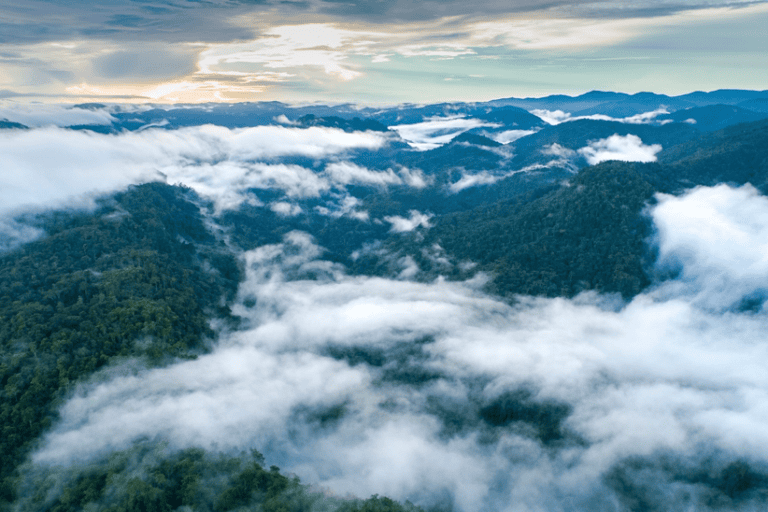- Indonesia’s West Papua province on the island of New Guinea has pledged to set aside 70 percent of its land area as protected or conservation areas. Local government decisions will be key to the plan’s success or failure.
- In the administrative district of Tambrauw within West Papua, local indigenous communities depend on the forest for their livelihoods.
- The head of Tambrauw district, Gabriel Asem, says he prioritizes the land rights of local communities and that conservation and sustainable development can go hand in hand.
For Mince, who is 40, and Atafia, 22, these green valleys in the west of the island of New Guinea are a second home, a place to hunt, to fish, to find medicines and to forage for sago, a crucial source of carbohydrates in the diet of the Momo Kaa indigenous community. For them, and for Atafia’s two toddlers, conservation of these Tambrauw hillsides carries a sense of immediacy.
“We can find sago, vegetables, fish, pigs or deer all here in the forest. And in the village we plant taro, sweet potatoes and chili,” Atafia tells Mongabay. “We never go hungry.”
I met the pair by accident. I happened to be in Ayapokiar, Atafia and Momo’s village in Tambrauw, along with 12 University of Papua students participating in a bird survey led by researcher Sebastian “Bas” van Balen and Mirza Kusrini from the university’s forestry department. In 2017, Van Balen followed in the footsteps of Henry Cushier Raven’s 1912-1914 journey through Borneo to document biodiversity declines. I was looking for a companion to enter the forest and ran into Agustinus Momo, who suggested her sister, Atafia.
She was at pains to make sure I had no problem working with a woman. “Here it’s much better,” she says. Whether it’s handling an unruly toddler at home or hauling sand on a construction site, women are generally considered the more diligent of the sexes. Atafia, for example, keeps watch over her two young children and helps pay the bills while her husband studies on a university scholarship in Palangkaraya, far away on the island of Borneo.

Sometimes Atafia brings a dog with her to take down a forest deer before she kills the animal with a spear, butchers the carcass and smokes the meat for preservation. “We don’t sell the venison, we eat it ourselves,” she said. “Because from here, everywhere is far.
“Even if I had the time to go to Sorong [the provincial capital], the transportation is 500,000 rupiah [$35] one way,” she says. The journey can take around eight hours.
This time Atafia and Momo have brought fishing rods. The Iri River is around a kilometer (0.6 miles) from camp. It might not sound far, but the steep, irregular inclines are enough to make pulses quicken. “This river is full of fish,” Atafia says.

The district chief, known in Indonesia as a bupati, of Tambrauw is Gabriel Asem, a well-built man with a mustache as thick as the tree line in the Tambrauw valleys. Gabriel was elected head of Tambrauw when the administrative district was first created, in 2008. In his office he explains to me that around 80 percent of the 11,000 square kilometers (4,250 square miles) that make up the district are conservation areas.
“In total there are 29 subdistricts and 216 villages in Tambrauw and we make the rules for protecting forests, beaches and elsewhere,” he told Mongabay last year. “It must all be agreed with the community of customary owners, because they have territorial rights.”
Gabriel says he has long been told that by prioritizing conservation of these valleys he will sacrifice development. He disagrees.
Indonesia’s statistics agency said in March 2018 that 35.3 percent of the rural population here in West Papua province lived in poverty (defined as the equivalent of 85 U.S. cents a day or less). That is the second-highest rate among the 34 provinces across Indonesia, while malnutrition remains one of the biggest killers of children under 5.

It’s a view in line with the larger development agenda in West Papua. Last October, the governors of West Papua and Papua provinces, which together make up the Indonesian half of New Guinea, signed a pledge to set aside 70 percent of their jurisdictions as protected or conservation areas. The region is home to some of the best forest left in Indonesia.

“We are very happy to be able to bring people here,” Atafia says. “They can see how us protecting the forests is good for our children and grandchildren.”
***
Een Irawan Putra is director of the Indonesia Nature Film Society, a media partner of Mongabay.
Banner: A flower in West Papua. Image by Rhett A. Butler/Mongabay.
This story was reported by Mongabay’s Indonesia team and was first published on our Indonesian site on Aug. 14, 2018.
Article appeared here - https://news.mongabay.com/2019/01/in-west-papua-a-development-plan-that-doesnt-require-clearing-forest/
No comments:
Post a Comment